If you were to write a list of the things you know about Australia, abundant wildlife and beautiful beaches would probably top the list. Not to take away from what you already know, but the world’s sixth-largest country also has a vibrant railway sector.
On more than 20,000 miles of railway track throughout the nation, Australia’s rail industry transports millions of passengers and freight.
Roughly 11,000 miles are standard gauge, mainly in New South Wales and on the interstate rail system. There’s close to 9,400 miles of narrow gauge track, mainly in Queensland, Western Australia, Tasmania, and a portion of South Australia.
Nearly 2,500 miles of the broad gauge are mainly in Victoria, including branch lines into southern New South Wales and some parts of South Australia.
The industry generates $18 billion in revenue annually and employs over 50,000 people across 961 businesses and agencies. There are public and private operators, freight and passenger carriers, track owners and managers, producers, and suppliers.
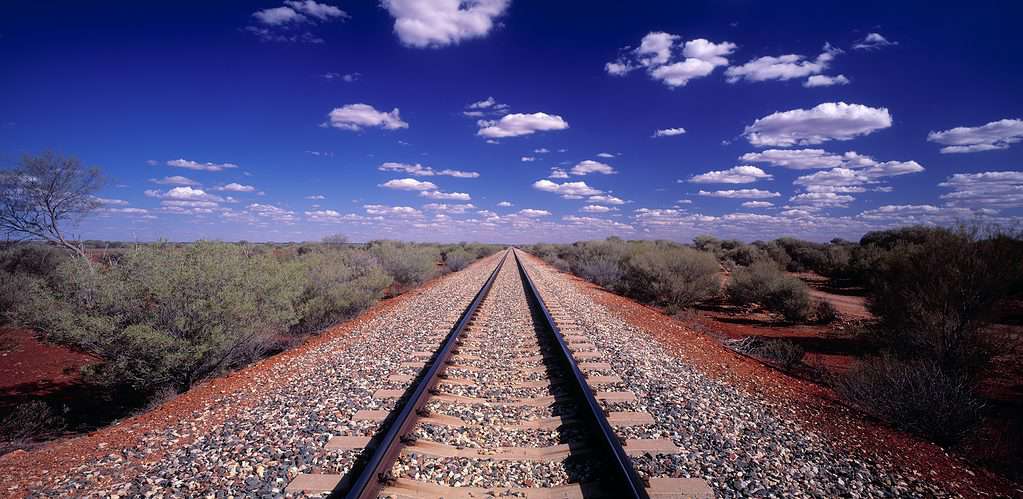
On more than 20,000 miles of railway track throughout the nation, Australia’s rail industry transports millions of passengers and freight.
©Janelle Lugge/Shutterstock.com
The Back Story
Private companies built Australia’s first railways to make transporting materials from remote areas to the closest capital city easier and to export those materials using the nearby port. Melbourne and Port Melbourne were served by the first railway, which began service in the 1850s.
There was low population density at the time. The need for rail travel between the various colonial capitals was not taken into account by either the entrepreneurs or the individual colonies that took over the development of the rail networks. Each state picked its gauge system.
The colonial masters devised a comprehensive rail network linking each capital city in the years before the Federation in 1901. But, then, there were no rail connections between Western Australia, the Northern Territory, and the other states.
In the 1930s, engineers converted Australia’s interstate network to a standard gauge track. The AUD 1.3 billion rail line between Alice Springs and Darwin, built by private operator FreightLink (now owned by Genesee and Wyoming), connected capital cities in January 2004.
The Iconic Indian Pacific Rail Journey
Australia is home to three historically significant long-distance passenger train journeys, Indian Pacific, The Overland, and The Ghan.
The Serco Asia Pacific-owned Great Southern Railway runs 3 round trips per week on The Overland between Melbourne and Adelaide, Adelaide-Alice Springs-Darwin via The Ghan on two weekly round trips, and the two weekly round trips on the Indian Pacific between Sydney and Adelaide and Perth.
Any of these journeys offer breathtaking scenery and vistas. In addition, some provide extraordinary onboard luxury and style as well as exceptional off-train activities.
There aren’t many actual transcontinental trains, but the Indian Pacific is one of them. The incredibly-long journey spans Australia in a whopping 2,704 miles. The wedge-tailed eagle, whose huge wingspan symbolizes the epic trip of an experience that spans a continent, is the emblem of the Indian Pacific.
The Indian Pacific train travels between the coasts of two of the world’s largest seas, giving it its name. You can board at either bustling Sydney in the east or beautiful Perth in the west.
You can travel the entire route in 4 days by train or split it into two shorter trips. The split includes a two-day trip from Sydney to Adelaide (or the other way around) and a three-day trip from Adelaide to Perth (or vice versa).
The train made its debut in February 1970, following the conclusion of gauge conversion projects in South Australia and Western Australia. This debut made it possible to travel across the continent without experiencing a gauge change. After trains on the Trans-Siberian and Canadian Railway, it was the third-longest passenger train, at the time, in terms of distance.
The 2,704-mile-long railroad is now the world’s second-largest, behind the Trans-Siberian Railway, which connects Moscow with Vladivostok and covers 5,715 miles.
The route crosses the vast desert of the Nullarbor Plain and includes the longest straight stretch of railroad track in the world, a 297-mile stretch from the goldfields near Kalgoorlie.
Depending on schedule and daylight saving time, a one-way trip used to last between 70.5 and 75 hours. Despite traveling a longer distance, the adventure now takes 65 hours, thanks to infrastructure upgrades and shorter turnaround times for personnel and locomotive changes. It also has a motorail service to carry passengers’ cars. Until November 2015, when passengers solely used the motorail service between Adelaide and Perth, it used to be accessible along the whole route.
The Indian Pacific links Perth to Sydney as a part of the Journey Beyond train service. This rail trip displays a highly diversified scenery as it passes through mountain ranges, parched deserts, goldfields, rocky valleys, and subtropical savannas. It’s similar to The Ghan but traverses east-to-west (or west-to-east).
In the peak of the season, the Indian Pacific leaves Sydney and Perth twice weekly. There is only one weekly return service available during the off-peak season.
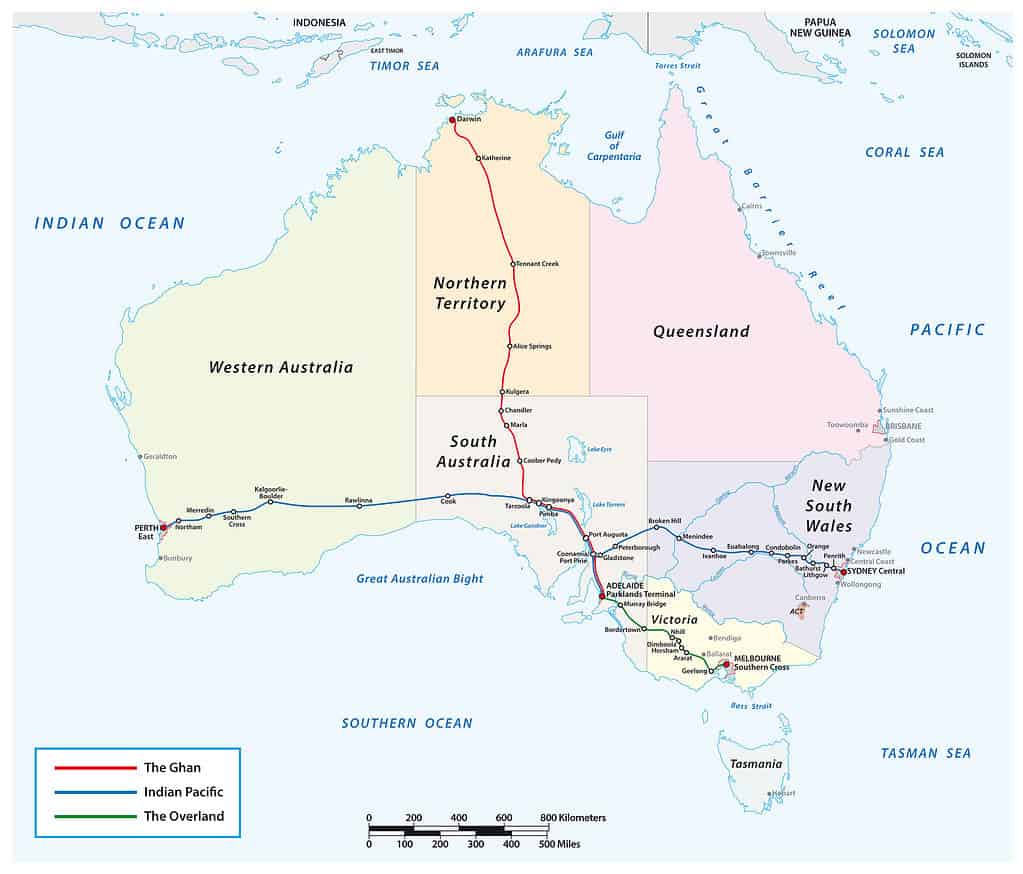
Australia is home to three historically significant long-distance passenger train journeys, Indian Pacific, The Overland, and The Ghan.
©iStock.com/Rainer Lesniewski
On Becoming Indian Pacific
In 1966, the Department of Railways of New South Wales, South Australian Railways, Commonwealth Railways, and Western Australian Government Railways decided to launch a direct passenger service from Sydney Central to East Perth Terminal. The launch was after the last surviving narrow gauge sections of the East-West rail corridor were being converted to standard gauge.
At a joint meeting of transport ministers in 1969, a decision was reached to change the name of the train service from The Transcontinental to Indian Pacific.
Until February 1993, the four operators of the areas the Indian Pacific passed through ran the service and shared expenses and income. Commonwealth Railways took 45%, Department of Railways New South Wales received 28.5%, Western Australian Government Railways earned 16.5%, and South Australian Railways collected 10%.
The Australian National fully controlled the service from 1993 to 1997 when Great Southern Rail acquired the Indian Pacific. As a result, it survived multiple changes in corporate ownership, which saw its name change from Journey Beyond Rail Expeditions to Journey Beyond.
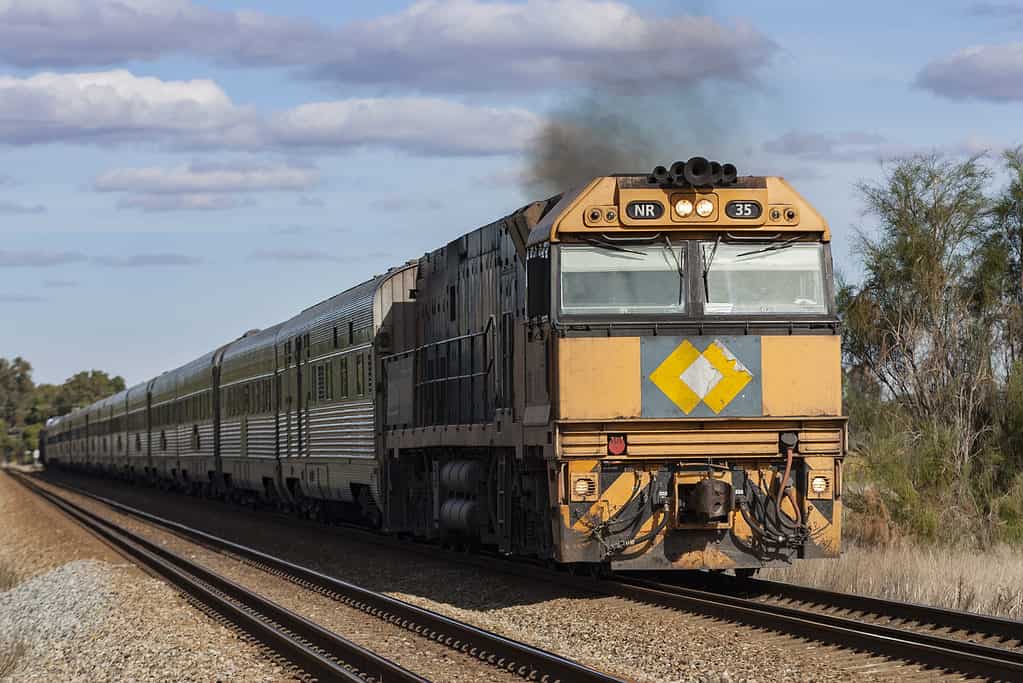
Australia’s Indian Pacific train travels between the coasts of two of the world’s largest seas, giving it its name.
©iStock.com/Yuki Ishii
Facilities Onboard
The Indian Pacific Railway has changed through the years to become a recognized icon for domestic and foreign travel. Since the 1990s, it has improved the quality of service to compete with domestic airlines. In 2016, it eliminated “cattle class” to provide a luxurious travel experience for all customers.
The Indian Pacific is a comfortable train with an air of elegance and a touch of cozy cabins. The dining car’s beautiful retro-Edwardian décor contrasts with the contemporary suites’ wooden furnishings. Both are outfitted with panoramic windows for ideal observation as the train travels by.
Platinum Service
Every Indian Pacific Platinum cabin offers a double bed, a roomy bathroom en suite, and full room service. They are decorated in a classic style with an unmistakably Australian feel.
The lounge-style setting of the cabins during the daytime includes a portable table and two seats.
Gold Service
This service features 9 Gold Twin accommodations for up to 18 passengers or 16 Gold Single cabins. The Gold Twin cabins can be used exclusively for an additional fee.
Gold Twin
The Gold Twin Berth Sleeper Cabins have a cozy three-seater lounge during the day that transforms into an upper and lower sleeping berth at night. Fresh bedding, towels, pillows, and complimentary toiletries are all part of the steward service provided by the hospitality staff member.
Compact private bathrooms with a toilet, sink, hair dryer, and shower are available in Gold Twin Berth Sleeper Cabins.
Gold Single
The Gold Single Berth Sleeper Cabins have a comfy chair and footrest for the day and a single-level bed for the night. There’s a wash basin, but the bathrooms and toilets are at the ends of the carriage.
Gold Superior
This service contains a lounge space, a TV and DVD player, power outlets, a mini-bar, a ¾-size double bed, and an additional fold-down upper sleeper. The quantity of the fast-selling Gold Superior Double Bed (with third upper bunk) cabins is strictly capped.
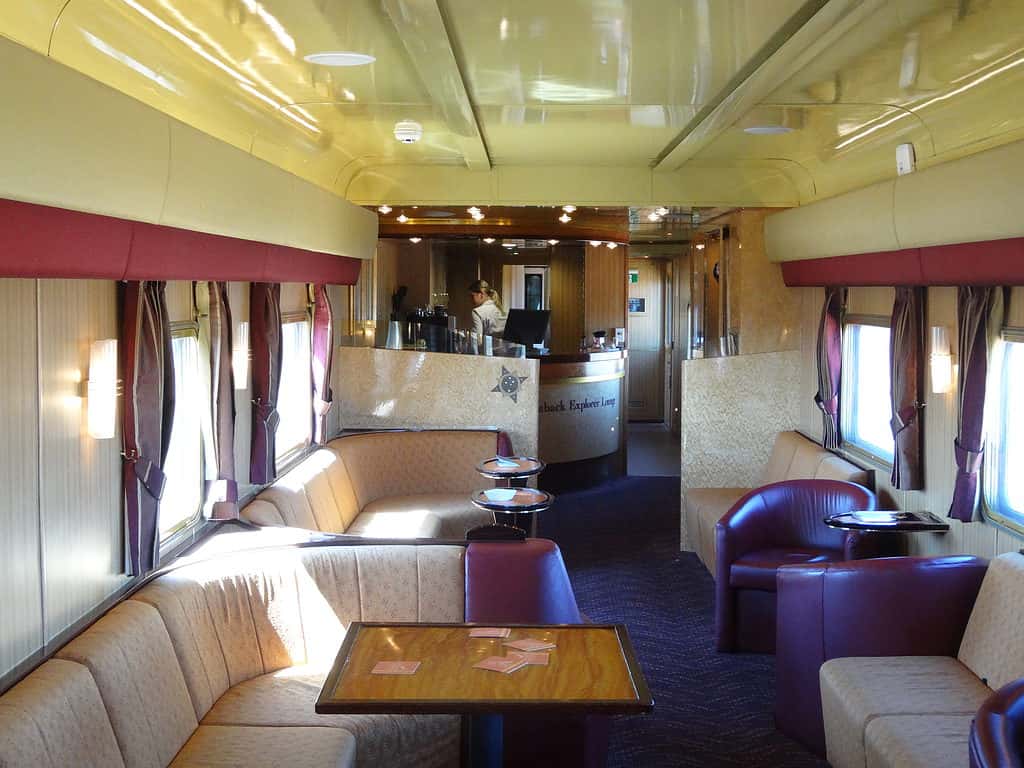
The Indian Pacific is a comfortable train with an air of elegance and windows for ideal observation as the train travels.
©denisbin / Flickr – License
THE INDIAN PACIFIC RAILWAY ROUTE
The Indian Pacific Railway travels the 2,704-mile journey in about three days or precisely 65 hours. East Perth Station is the train’s starting point, which initially shares tracks with the Midland Suburban Railway.
From there, the Spencer Gulf’s northernmost point, Port Augusta, is reached through the Trans-Australian Railway. Then, the route continues in a southeasterly direction into Port Pirie before entering Adelaide, the capital city of South Australia.
The train makes a double-back to Crystal Book before continuing eastward, changing to the Broken Hill route. It travels through the New South Wales Blue Mountains into Parkes before arriving at Sydney Central Station, which marks the end of the trip.
The train travels across Western Australia, South Australia, and New South Wales, stopping only at East Perth, Kalgoorlie, Rawlinna, Cook, Adelaide, Broken Hill, Mount Victoria, and Sydney throughout the lengthy journey.
OFF-TRAIN EXPERIENCES
The popularity of the transcontinental Indian Pacific is undeniable. On average, tickets are sold out six months in advance. However, the train line now serves as much more than just a conduit between two points. The final destination is less significant than the experiences enjoyed.
Although off-train activities are subject to change, you can expect to participate in the following while traversing from Sydney to Perth on the Indian Pacific.
As you travel from Sydney to Perth, enjoy views of the majestic Blue Mountains, adventures in Broken Hill, and South Australia’s world-famous wine regions. A memorable seasonal dinner under the stars through the Nullarbor Plain is also available.
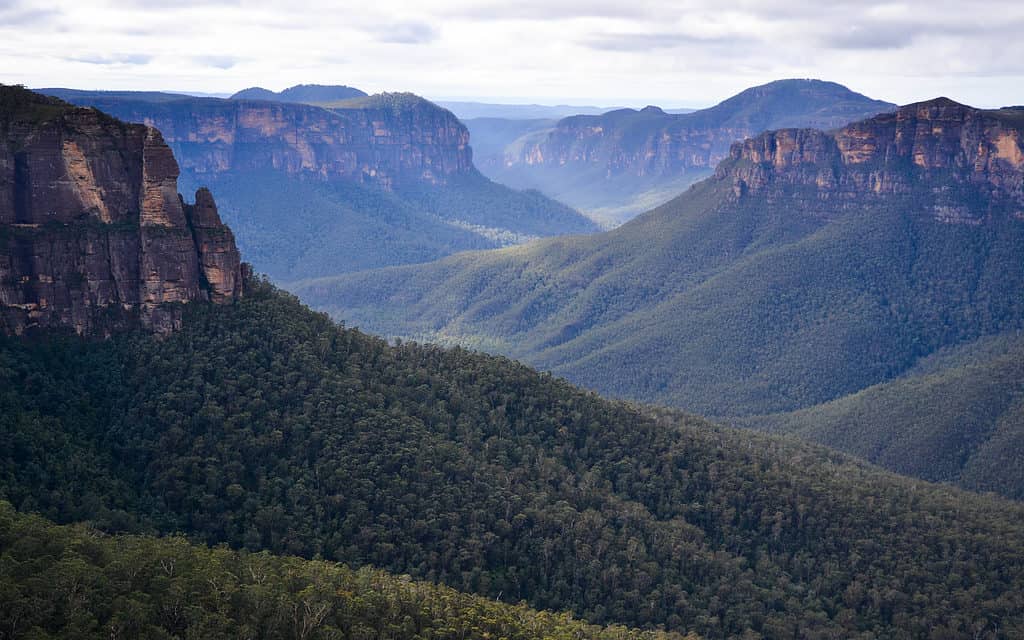
As you travel from Sydney to Perth, passengers can enjoy views of the majestic Blue Mountains.
©Yoann Neb/Shutterstock.com
There are a variety of alternatives to suit every preference. Whether visitors want to learn about Adelaide’s history and culture at the South Australian Museum or wine tasting in a well-known wine region like the Barossa or McLaren Vale. They can also enjoy the regional specialties in the Adelaide Hills.
Before boarding, there is a free Flavors of South Australia welcome dinner at the Adelaide Parklands Terminal for travelers boarding the train in Adelaide on their way to Perth.
Also, you can discover the history of mining while exploring the peculiarities of Silver City.
Passengers can take a break from their westward journey and stroll through Cook, a historic railroad town.
If you’re traveling between October and March, enjoy dinner under a starry sky.
Off the train on the eastward trip from Perth to Sydney, you can visit Kalgoorlie, the largest regional city in Western Australia, and learn more about it. Look out for colonial Australia’s early gold rush characteristics and the sense of adventure said to still be present in the region.
Discover the lovely structures and attractions of North Terrace’s cultural boulevard. A tasting tour at the famous, fresh produce Adelaide Central Market is another experience you shouldn’t sleep on. The market has been a favorite of the locals for 140 years.
Other highlights on the Perth-Sydney route include the ever-picturesque Blue Mountains, an outback breakfast experience, and Broken Hill and Kalgoorlie mining towns.
Up Next
Check out some of our other train articles below.
- The 6 Longest Train Trips on Earth: If you have the time to spare, consider one of these long train rides.
- 10 Most Expensive Train Trips In The World: These train rides will cost a pretty penny, but they are worth it!
- The 7 Most Beautiful Train Rides On Earth: If you prefer scenery, check out these amazing train rides, known for their beauty.
- See Inside Japan’s First Class Private Overnight Train: You won’t believe what this overnight train ride offers.
The photo featured at the top of this post is © Stilgherrian / Flickr – License / Original
Sources
- SBS, Available here: https://www.sbs.com.au/guide/article/2021/07/15/indian-pacific-australias-longest-train-journey-trip-worth-taking
- Aussie Trains, Available here: https://aussietrains.com.au/indian-pacific/
- Wikipedia, Available here: https://en.wikipedia.org/wiki/Indian_Pacific
- Journey Beyond Rail, Available here: https://www.journeybeyondrail.com.au/journeys/indian-pacific/
Thank you for reading! Have some feedback for us? Contact the AZ Animals editorial team.






